May
5
the golden week
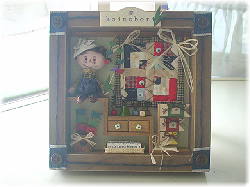 We're in the middle of the golden week. You may know that three national holidays are in a row in the first week of May and there is another national holiday at the end of April in Japan. So, if the timing is good, you can get a week off from work. It's called the golden week.
We're in the middle of the golden week. You may know that three national holidays are in a row in the first week of May and there is another national holiday at the end of April in Japan. So, if the timing is good, you can get a week off from work. It's called the golden week.
May the 5th is traditionally called Tango no sekku and it's originally a festival for boys.
But it's called kodomo no hi means "Children's day" recently. Yet, the traditional custom is still alive. We raise some carp streamers outside to celebrate the day because a carp is regarded as a symbol of courage since it swims upstream against the current. Those carp streamers are koi nobori means "rising carps or carp flags".
We also display special dolls called Mushaningyou which are modeled after the warriors of the Middle Ages. Both of them are for wishing boys to grow up strong. So the day is turned now for wishing all the children (both boys and girls) to grow up healthy and strong.
See the handcraft frame in the picture above. There are some koi nobori shaped items and a boy with kabuto is sitting on a wood shelf. Kabuto is an old-fashioned helmet which was used in the Middle Ages. Shoubu or Japanese irises are also in the frame because the flower is a symbol of Tango no sekku. The word shoubu is also means "win or lose", which is a symbolic word for brave warriors. I think it's a pun.
As you know that the Japanese summer is hot and unbearably humid, this is the best season for us before the rainy season called tsuyu in June and the unpleasant summer.
Categories:
events
,
handcrafts
Apr
11
cherry blossoms
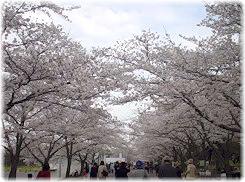 April is the season of cherry blossoms. The pink flowers bloom in the southern part of Japan first and gradually move north. The season itself becomes warmer and warmer, so I think this is the best season for us. As you see in the picture, the flowers look like pink clouds.
April is the season of cherry blossoms. The pink flowers bloom in the southern part of Japan first and gradually move north. The season itself becomes warmer and warmer, so I think this is the best season for us. As you see in the picture, the flowers look like pink clouds.
There are many hanami spots (means "suitable place to see the flowers") in this Kansai area as well as in the other parts of Japan. Many people have a picnic style party under the trees with cherry blossoms blooming in full force. It's pleasant to eat and drink outdoors.
If you plan on visiting Japan, I recommend this season. However, as the flowers fall within a week or two, you should choose the right time. The best time is usually the second week of April around Osaka in Kansai area, a bit after that around Tokyo in Kantou area.
The following pictures are some of my best shots of cherry blossoms. Aren't they beautiful?
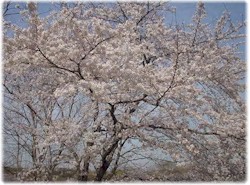
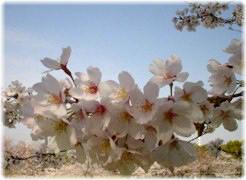
Taken in the Expo'70 Memorial Park in Osaka
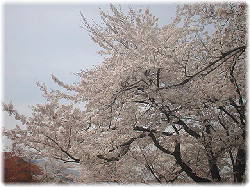
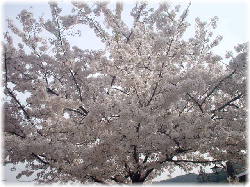
Taken in Arashiyama in Kyoto
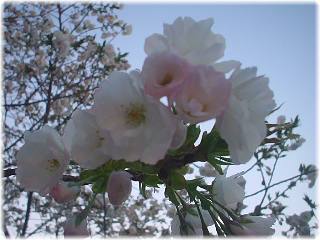
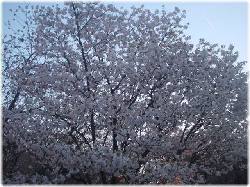
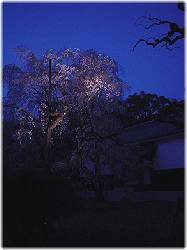
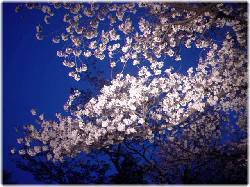
Taken in the Nijou Castle in Kyoto
Cherry blossoms are beautiful not only in the daytime but also at night. We often enjoy yozakura kenbutsu (means "enjoy seeing cherry blossoms at night"). The beauty of it is much different from that in the daylight.
Categories:
events
Feb
29
Hina-matsuri
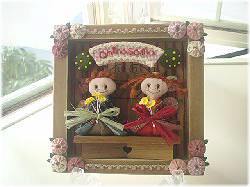 Here's another handcraft frame. This is for March. The theme is Hina-matsuri because we celebrate the day for girls on March 3rd.
Here's another handcraft frame. This is for March. The theme is Hina-matsuri because we celebrate the day for girls on March 3rd.
Hina means dolls which we display to celebrate the day and matsuri means a festival. So Hina-matsuri literally means "Dolls' Festival".
They say that the beginning of this festival goes back to Japanese medieval era called Heian Jidai. So the history is very long and old.
The dolls in my frame are very small and simple but the real hinas are more luxurious and larger. A five-staged decoration is a formal style.
A prince and a princess are on the top stage, three maids on the second stage, five musicians which play Japanese traditional instruments on the third, one minister is on both sides of the fourth stage and three followers are on the fifth. The clothes they wear are in Heian style. The aristocratic people in those days wore more complicated kimono than people in Edo era.
In addition to the dolls, imitations of cars, designed floor lights called bonbori, rhomboid sweets and flowers are displayed with them. So the real five-staged decoration for Hina-matsuri is very gorgeous.
We do the festival mainly for girls to exorcise and to pray for good health. There is another festival called Tango no sekku for boys in May.
Hina-matsuri is also called momo no sekku. Momo means a peach and sekku means a punctuation of a season. Peach blossoms are blooming in March and the season is gradually changing into spring. That is because Hina-matsuri is also called mono no sekku.
Well, now we're almost in March. Spring is approaching.
Categories:
events
,
handcrafts
Jan
16 February is approaching
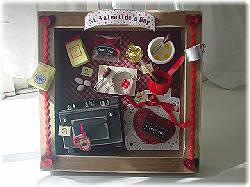 The picture is a doll house like mini frame of which the theme is St.
Valentine's Day. I bought a series of handcraft kits to make this kind
of frame and this is one of them. This one expresses 4 steps to bake a
chocolate cake.
The picture is a doll house like mini frame of which the theme is St.
Valentine's Day. I bought a series of handcraft kits to make this kind
of frame and this is one of them. This one expresses 4 steps to bake a
chocolate cake.
1. materials
2. mix the materials
3. bake a cake in an oven
4. completed
And around the frame, there are a bag of flour, a measuring cup, 4 red
buttons, wavy ribbons on the both sides, and the title board "St.
Valentine' Day" at the top of the frame.
As St. Valentine's day is already commercialized in Japan, many shops
concentrate on selling chocolates for the day after New Year celebration
is over. Many people buy those chocolates not only for their target one
but also friends or familiar people around them. So the custom has
almost become nominal these days. But the special wrappings and window
displays are beautiful and people enjoy and use the day to express their
gratitude each other. It's OK, isn't it? I think the Westerners wonder
why only chocolates are for Valentine's day. In Japan, maybe from the
start, it was a plot or conspiracy (laugh) of chocolate makers to sell
their products. So St. Valentine's day in Japan is much different from
its original custom and style. Anyway now February is approaching.
The following photos are the series of mini frames and each of them
expresses a seasonal theme one by one. I'll up more photos of them in
the mean time.
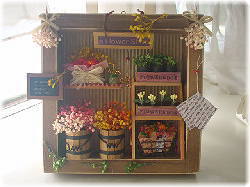 *** April ***
*** April ***
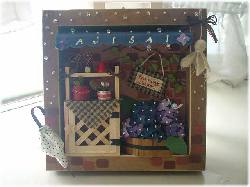 *** June ***
*** June ***
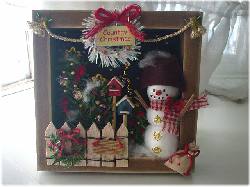 *** December ***
*** December ***
Categories:
events
,
handcrafts
Jan
04 A Happy New Year!
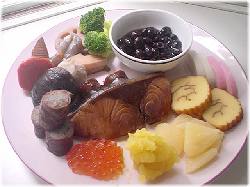 Now we're in 2012. Some of you may know, the Japanese biggest annual
event is New Year's Day. We celebrate the beginning of the year with
special dishes and new year parties, like westerners celebrate Christmas
Day.
Now we're in 2012. Some of you may know, the Japanese biggest annual
event is New Year's Day. We celebrate the beginning of the year with
special dishes and new year parties, like westerners celebrate Christmas
Day.
The photo is an "osechi" plate which contains traditional
items for new year celebration. I made these. Traditionally we use "jyuu-bako",
literally means "piled boxes", but this kind of hors
d'oeuvre style plate is also popular recently. In addition to those
dishes, we prepare many luxurious foods and drinks, visit shrines, watch
special TV programs during New Year holiday, while many people enjoy
traveling, skiing or some other things outside.
The following photo is "nerikiri" which is made of soybean
paste called "an" or "anko" and those are
shaped like flowers or birds. Aren't they beautiful? "Nerikiri"
is not only for New Year's day, but as those are a little bit expensive
for daily life, those are rather for special events.
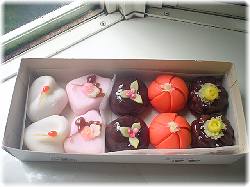
I'm now enjoying lazy New Year holiday with eating, sleeping, watching
videos after demanding "oosouji", means "cleaning house
totally". (We customarily do it at the end of a year to celebrate New
Year's Day and it's not an easy work.) Spending New Year holiday this
way is called "ne-shougatsu" means "sleeping away lazily".
(laugh)
Categories:
diary
,
events
,
foods
Dec
24 welcome to my blog!
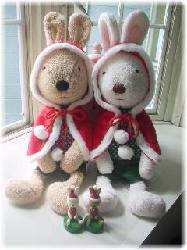 Merry Christmas! The photo is my favorite x’mas bunnies. Do you know
them? These are the "le sucre" bunnies which designed by Naomi Tozaki, a
Japanese artist. Cute, aren't they? This is a typical example of
Japanese word "kawaii " means. I'll up more pictures of them
in the mean time.
Merry Christmas! The photo is my favorite x’mas bunnies. Do you know
them? These are the "le sucre" bunnies which designed by Naomi Tozaki, a
Japanese artist. Cute, aren't they? This is a typical example of
Japanese word "kawaii " means. I'll up more pictures of them
in the mean time.
Well, Enjoy your Christmas holiday!
Categories:
events
,
favorites
 We're in the middle of the golden week. You may know that three national holidays are in a row in the first week of May and there is another national holiday at the end of April in Japan. So, if the timing is good, you can get a week off from work. It's called the golden week.
We're in the middle of the golden week. You may know that three national holidays are in a row in the first week of May and there is another national holiday at the end of April in Japan. So, if the timing is good, you can get a week off from work. It's called the golden week.  April is the season of cherry blossoms. The pink flowers bloom in the southern part of Japan first and gradually move north. The season itself becomes warmer and warmer, so I think this is the best season for us. As you see in the picture, the flowers look like pink clouds.
April is the season of cherry blossoms. The pink flowers bloom in the southern part of Japan first and gradually move north. The season itself becomes warmer and warmer, so I think this is the best season for us. As you see in the picture, the flowers look like pink clouds.









 Here's another handcraft frame. This is for March. The theme is Hina-matsuri because we celebrate the day for girls on March 3rd.
Here's another handcraft frame. This is for March. The theme is Hina-matsuri because we celebrate the day for girls on March 3rd.  The picture is a doll house like mini frame of which the theme is St.
Valentine's Day. I bought a series of handcraft kits to make this kind
of frame and this is one of them. This one expresses 4 steps to bake a
chocolate cake.
The picture is a doll house like mini frame of which the theme is St.
Valentine's Day. I bought a series of handcraft kits to make this kind
of frame and this is one of them. This one expresses 4 steps to bake a
chocolate cake.
 *** April ***
*** April ***
 *** June ***
*** June ***
 *** December ***
*** December ***
 Now we're in 2012. Some of you may know, the Japanese biggest annual
event is New Year's Day. We celebrate the beginning of the year with
special dishes and new year parties, like westerners celebrate Christmas
Day.
Now we're in 2012. Some of you may know, the Japanese biggest annual
event is New Year's Day. We celebrate the beginning of the year with
special dishes and new year parties, like westerners celebrate Christmas
Day.

 Merry Christmas! The photo is my favorite x’mas bunnies. Do you know
them? These are the "le sucre" bunnies which designed by Naomi Tozaki, a
Japanese artist. Cute, aren't they? This is a typical example of
Japanese word "kawaii " means. I'll up more pictures of them
in the mean time.
Merry Christmas! The photo is my favorite x’mas bunnies. Do you know
them? These are the "le sucre" bunnies which designed by Naomi Tozaki, a
Japanese artist. Cute, aren't they? This is a typical example of
Japanese word "kawaii " means. I'll up more pictures of them
in the mean time.